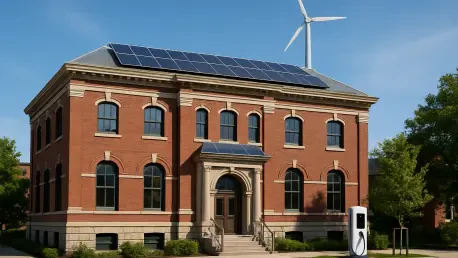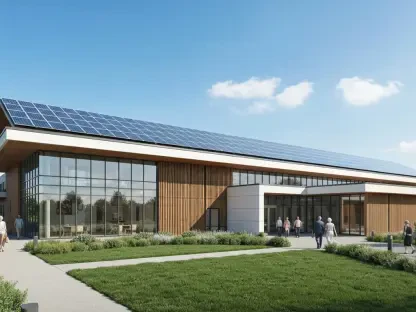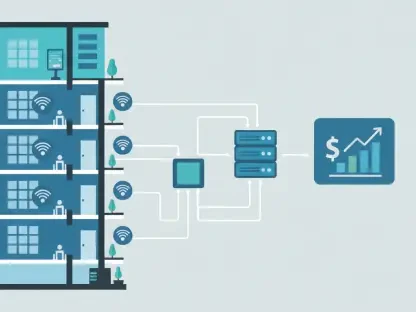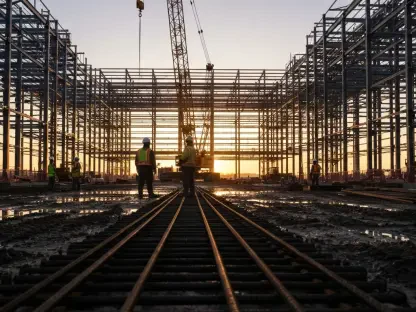In a bold stride toward sustainability, the McKnight Foundation, a prominent Minnesota-based nonprofit, has transformed a 140-year-old historic building in downtown Minneapolis into a fully decarbonized headquarters, setting a new standard for environmental innovation. Spanning 45,000 square feet across two storefronts dating back to 1883 and 1890 on Washington Avenue, this space operates entirely without natural gas—a significant feat in a state where buildings account for 18% of greenhouse gas emissions. This ambitious project not only reimagines the foundation’s workspace but also positions it as a trailblazer in demonstrating how older structures can play a pivotal role in combating climate change. By merging preservation with cutting-edge technology, McKnight challenges the notion that historic buildings are incompatible with modern energy efficiency, offering a compelling model for urban renewal.
Innovative Technologies Powering Sustainability
Breaking Away from Fossil Fuels
The cornerstone of this transformative retrofit lies in the complete elimination of natural gas, a primary source of pollution in Minnesota’s building sector. Instead, the foundation embraced an unconventional solution for a structure of this scale: thermal energy tanks. Often compared to oversized thermoses, these tanks generate ice during off-peak nighttime hours to cool the building during the day, while also storing excess heat in winter for later use. This technology, typically seen in warmer climates like the Southwest, has been skillfully adapted to withstand Minnesota’s rigorous winters, showcasing its versatility. Ben Passer, director of the Midwest Climate and Energy program at McKnight, emphasized the rarity of this application in colder regions, underscoring the project’s intent to prove that such systems can thrive beyond their traditional geographic boundaries. This innovative approach marks a significant departure from conventional heating and cooling methods, paving the way for broader adoption in similar climates.
A deeper look into the system’s impact reveals its potential to redefine energy consumption patterns in historic renovations. By leveraging off-peak energy for cooling and heating, the thermal energy tanks not only reduce operational costs but also alleviate strain on the electrical grid during high-demand periods. This strategic energy management aligns with broader sustainability goals, minimizing the building’s carbon footprint while maintaining occupant comfort. Furthermore, the successful implementation in a 140-year-old structure dispels myths about the limitations of older buildings in achieving modern efficiency standards. The project serves as a proof of concept, illustrating that with creative engineering, even the most challenging spaces can contribute to environmental goals. This achievement could inspire property owners and developers to explore similar technologies, potentially transforming how urban areas address building-related emissions.
Sustainable Materials and High Standards
Beyond energy innovation, the retrofit prioritized the use of eco-friendly materials to further its environmental mission. Through a partnership with Habitable, an organization dedicated to low-impact construction, McKnight sourced recycled resources that were diverted from landfills, integrating them into the building’s redesign. Laura Salveson, the foundation’s director of facilities, highlighted how this commitment to sustainable sourcing reduced the project’s overall ecological impact. The result of these efforts is reflected in the building’s prestigious Gold ranking on the Leadership in Energy and Environmental Design (LEED) scale, awarded by the U.S. Green Building Council. Earning such a high certification is particularly noteworthy for a historic structure, as older buildings often face unique obstacles in meeting contemporary efficiency benchmarks. This recognition validates the meticulous planning and execution behind the retrofit.
Equally important is the broader implication of achieving LEED Gold status in a building of this age, as it challenges preconceived notions about the feasibility of green certifications for historic properties. The use of sustainable materials not only minimized waste but also preserved the cultural and architectural integrity of the original structure, striking a balance between heritage and innovation. This dual focus on environmental responsibility and historical preservation offers a blueprint for other organizations looking to renovate rather than rebuild. By demonstrating that sustainability and history can coexist, McKnight’s project encourages a shift in perspective within the construction and real estate sectors. It suggests that with the right partnerships and dedication, older buildings can be reimagined as exemplars of green design, contributing to a more sustainable urban landscape without sacrificing their unique character.
Community and Resilience at the Core
A Space for Connection and Support
At the heart of McKnight’s vision for its new headquarters is the idea of creating more than just an office—it’s a resilience hub designed to serve the surrounding community. Drawing inspiration from grantees like the Sabathani Community Center and the Minneapolis American Indian Center, both of which have implemented energy efficiency upgrades through initiatives like Xcel Energy’s Resilience Hubs program, McKnight aimed to craft a space that supports local stability. President Tonya Allen stressed the importance of maintaining a presence in downtown Minneapolis, opting for a larger footprint to accommodate conferences, meetings, and events for grantees and visitors. Since opening its doors in May, the building has hosted over 2,000 guests, evidencing its role as a vibrant communal resource. This active engagement underscores the foundation’s commitment to weaving itself into the fabric of the neighborhood, fostering collaboration and connection.
The significance of this community-centric approach extends beyond mere accessibility, as it positions the headquarters as a vital asset during times of need. By serving as a resilience hub, the building offers a stable power source and gathering space, capable of supporting the area during emergencies or extreme weather events—a growing concern in the face of climate change. This focus on community support reflects a broader understanding of sustainability that encompasses social as well as environmental dimensions. The foundation’s decision to prioritize local engagement through its physical space demonstrates a holistic view of climate action, where infrastructure serves not just operational needs but also societal well-being. Such a model could encourage other organizations to consider how their facilities can contribute to neighborhood resilience, amplifying the impact of individual projects on a collective scale.
Financial Support and Policy Alignment
The financial underpinnings of this ambitious retrofit highlight the crucial role of government incentives in driving private sector climate initiatives. McKnight secured $1.5 million in federal tax credits through the Inflation Reduction Act, a substantial boost that helped offset the costs of implementing advanced technologies and sustainable materials. This support illustrates how policy frameworks can enable organizations to pursue environmentally responsible projects that might otherwise be financially prohibitive. Additionally, the foundation’s strategic increase in environmental grantmaking, with significant allocations directed toward Midwest climate and energy projects, complements these incentives. Despite potential uncertainties in national policy, McKnight remains steadfast in its focus on state and local impact, ensuring that its efforts align with regional priorities and needs.
Equally critical is the foundation’s emphasis on tailoring climate action to community-specific contexts, as advocated by Tonya Allen. By fostering dialogue around local experiences—such as the effects of extreme weather on infrastructure and agriculture—McKnight seeks to develop solutions that resonate with Minnesotans on a personal level. This localized approach not only enhances the relevance of its initiatives but also builds trust and collaboration among stakeholders. The interplay between federal support and grassroots focus creates a robust framework for sustained environmental progress, demonstrating how diverse levels of intervention can work in tandem. As a result, this project stands as a testament to the power of aligned financial and policy mechanisms in catalyzing meaningful change, offering a replicable strategy for other nonprofits and private entities aiming to address climate challenges within their own communities.
Reflecting on a Groundbreaking Milestone
Looking back, the McKnight Foundation’s decarbonization of its historic Minneapolis headquarters marked a pivotal moment in blending technological innovation with environmental and communal responsibility. The elimination of natural gas, adoption of thermal energy tanks, and use of sustainable materials culminated in a LEED Gold certification that redefined possibilities for older structures. The building’s role as a resilience hub further embedded it within the local community, hosting thousands for events and standing ready as a bastion of stability. Financial incentives and a localized policy focus underpinned the project’s success, showcasing the synergy between public support and private initiative. Moving forward, this endeavor provides a clear path for others to follow, urging organizations to explore retrofitting as a viable strategy for sustainability. It also calls for continued advocacy for policies that incentivize green innovation, ensuring that such transformative projects become the norm rather than the exception in the ongoing effort to mitigate climate impacts.









